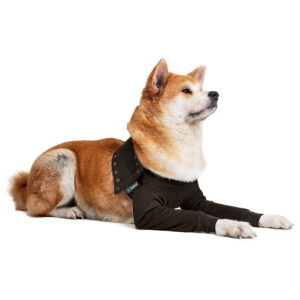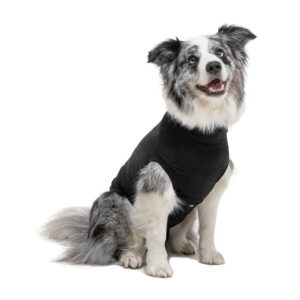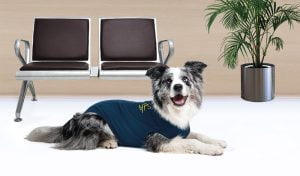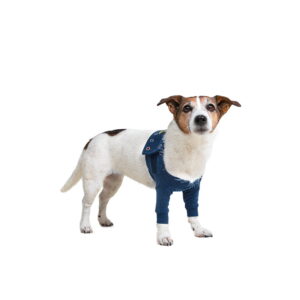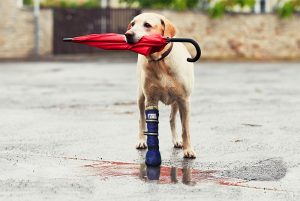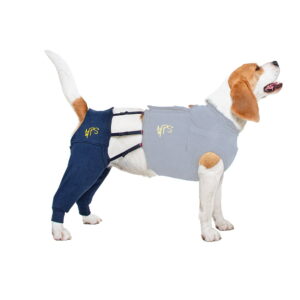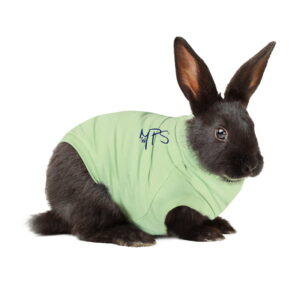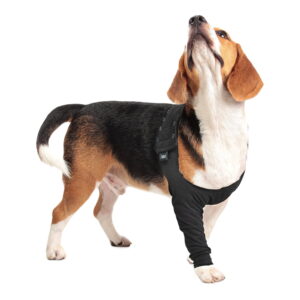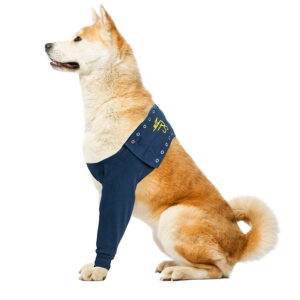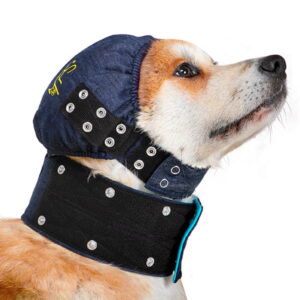The Vet’s Choice: Recovery Suits, Sleeves, Boots & Head Covers for Dogs and Cats
If your vet has suggested a cone, suit, or sleeve, you’re likely caring for a pet after surgery, a hotspot, a wound, or a skin condition. Recovery suits (post-surgery onesies) are a comfortable cone alternative many vets prefer because they stop licking and scratching while letting pets sleep, eat, and move normally. In this guide, we explain when to choose a recovery suit vs a cone, what to buy for spay/neuter recovery, how IV-friendly sleeves, paw boots, and ear caps are used in clinic and at home, and how to measure for the perfect fit. Then, when you’re ready, you can shop the exact product your vet would pick.
When to choose a recovery suit vs a cone (E-collar)
Recovery suits and cones both protect healing areas, but they shine in different scenarios.
- Choose a recovery suit when:
– You need a cone alternative that’s easier for sleeping, eating, and navigating tight spaces. – Your pet is anxious in a cone, or your cat refuses to eat/drink with an E-collar. – You want discreet coverage for spay/neuter incisions with potty/litter access. – You need to keep dressings clean and secure without constant supervision. Shop: Suitical Dog Recovery Suit • Suitical Cat Recovery Suit
- Choose a cone (or suit + cone) when:
– The surgery site is on the face, eyes, or areas a suit cannot cover. – Your pet is an extreme chewer or very determined licker. Tip: Many vets pair a recovery suit with a soft cone during unsupervised times for “belt-and-braces” protection.
Post-spay/neuter recovery: what your dog or cat needs
- What to buy: A well-fitted dog or cat recovery suit (post-surgery onesie) designed as a cone alternative with easy potty/litter access.
Shop: Suitical Dog Recovery Suit • Suitical Cat Recovery Suit
- Toileting access:
– Dogs: Use the built-in rear panel that snaps or folds back for quick toilet breaks. – Cats: Litter box use is safe and easy; keep the rear panel open when needed, then close again to protect the incision.
- How long to wear:
– Most vets advise 7–14 days post-op or until your vet confirms healing. Check daily for discharge, redness, or swelling.
- Can pets sleep in a recovery suit?
– Yes. The gentle, snug fit helps many pets settle better than with a cone.
Cooling vests for heat stress and medical conditions
The At Home Dry Cooling Shirt is a full-body cooling vest that covers chest, belly, and back. Fill the inner layer with water via the secure valve; evaporative cooling helps regulate temperature on warm days.
- When cooling helps:
– Heat stress in summer, recovery comfort, certain cardiac/respiratory conditions (use only under vet guidance). – Brachycephalic breeds (Pugs, Bulldogs): cooling can help, but never rely on cooling alone—avoid midday heat and monitor closely.
- Safe use:
– Pre-cool with clean water, wring to damp (not dripping), and check the skin every 1–2 hours. – Replace or re-wet when warm. Do not use if your pet is shivering or chilled. Shop: At Home Dry Cooling Shirt
Calming pressure shirts for anxious pets after surgery
The MPS 4-in-1 shirt combines a full recovery suit with an adjustable calming effect. Gentle, even pressure can soothe post-op anxiety and is also helpful during fireworks and storms.
- Why vets recommend it:
– Adjustable straps let you fine-tune calming pressure while keeping the surgical site covered and clean. – Dual-use: post-op protection now, behavior support later. Shop: MPS 4-in-1 Shirt (Calming Pressure + Recovery)
IV-friendly sleeves and secure placement
In clinics and at home, an IV-friendly sleeve keeps lines or bandages protected without relying solely on tape.
- What to look for:
– Dedicated openings or channels for IV placement, breathable but robust fabric, and secure, non-slip fastenings. – Single front- or hind-leg sleeves, plus “double” designs that protect both front or both hind legs. Shop: Suitical Recovery Sleeve (Dog) • MPS Hind-Leg Sleeves (Dog)
Hind-leg sleeves and paw boots (when and how to use)
- Hind-leg sleeves:
– Great for post-surgery coverage, hotspots, or lick granulomas on thighs or shins. – Choose single or double designs for stability and to reduce twisting. Measure leg circumference for best fit. Shop: MPS Veterinary Range Hind-Leg Sleeves (Dog)
- Paw recovery boots:
– Ideal when the paw or lower leg needs to stay clean and dry. – Use a waterproof, breathable boot over dressings to keep out dirt and moisture during short outdoor trips. – Check frequently for moisture buildup and remove at rest to let the skin breathe. Shop: MPS Veterinary Range Paw Recovery Boot
Head covers for ear infections, hematomas, and wound care
Head caps protect delicate ear areas, prevent scratching, and secure dressings after ear surgery or hematoma treatment.
- Features vets love:
– Side pockets for extra padding – Soft, secure straps for a snug, comfortable fit – Easy inspection without fully removing the cap Shop: MPS Veterinary Range Head Cover (Dog)
Keeping it tidy: pockets and add-ons
Many medical recovery shirts include extra fastenings or pocket areas to hold:
- Portable ECG readers
- Portable infusion systems
- Extra padding
- Sanitary pads
- Cooling packs
Always follow your vet’s instructions for any device or dressing you attach.
How to measure and choose the right size
A good fit keeps your pet safe and comfortable.
- Back length: From the base of the neck (between the shoulder blades) to the base of the tail.
- Chest girth: Around the widest part of the ribcage.
- Neck girth: Around the base of the neck.
- Leg circumference (for sleeves): Measure above and below the joint the sleeve will cover.
- Breed tips:
– Long-back breeds (Dachshunds): choose a long-body fit to prevent pulling at the rear panel. – Large, deep-chested dogs (Labs, GSDs): prioritise chest girth, then adjust straps. – Cats: pick the cat-specific suit for better litter access and slimmer proportions.
Questions about size? Check our size chart and Fit Finder, and review our easy exchanges policy so you can order with confidence.
Suitical vs MPS: quick comparison
Both are trusted, vet-recommended brands. Here’s how to decide:
- Suitical highlights:
– Soft, stretchy fabric with breathable coverage – Clever potty/litter access panels – Wide at-home range for dogs and cats
- MPS Veterinary Range highlights:
– Clinic-ready durability and secure strapping – Specialty items (double sleeves, hind-leg sleeves, head caps, paw boots) – Adjustable 4-in-1 calming recovery shirt
FAQs
- Are recovery suits better than cones?
It depends on the surgery and your pet. For body incisions (spay/neuter, abdominal, flank), suits are a comfortable cone alternative. For facial/eye surgeries, a cone (or suit plus cone) is often required. Ask your vet which is right for your case.
- Can cats use the litter box in a recovery suit?
Yes. Cat-specific suits have rear access that folds back for toileting, then closes to protect the incision. Keep litter clean and low-dust during recovery.
- How long should a dog wear a recovery suit after surgery?
Typically 7–14 days, or as directed by your vet. Check the site daily and keep the suit clean and dry.
- Can dogs sleep in a recovery suit?
Absolutely. Most settle better than with a cone. Ensure the suit fits snugly but isn’t tight, and check for rubbing at armpits or belly.
- How do I measure my dog for a recovery suit?
Measure back length (neck to tail base), chest girth, and neck girth. Between sizes, choose based on chest girth and adjust straps.
- How do I prevent licking stitches without a cone?
Use a well-fitted recovery suit that fully covers the incision. For determined lickers, combine the suit with a soft cone when unsupervised.
- Is a cooling vest safe for brachycephalic breeds?
Yes, with care. Use a damp (not dripping) vest, avoid heat and strenuous exercise, and monitor closely. Cooling vests are supportive tools, not a license to stay out in the heat.
Need a hand? Chat with us and we’ll help you choose the right recovery suit or sleeve, confirm sizing, and get your pet comfy—fast.

